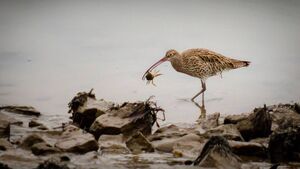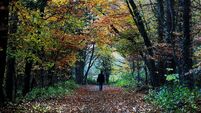Curlew and skylark: a tale of two birds

A curlew just after catching a lovely fresh crab for lunch at low tide at Monkstown, Co Cork. This was one of the winners in the Irish Examiner's photographic competition in 2022. Picture: Brian Fahy
The sounds of old, the songs of lark and curlew, like the smell of baked bread or a smoker’s pipe, are strong in their ability to bring back fond memories. Over the years, the waft of pipe smoke has faded and, alas, so too has the song of the curlew.
Thankfully, the Lark, or Skylark, still soars and sings but the curlew has been driven to the point of extinction. All hope is not lost however and great efforts are being made by highly enthusiastic teams to ensure that the cry of the curlew will be heard again on summer evenings.
I remember the tune, , being played each Sunday morning as the late Ciarán MacMathúna introduced , an Irish radio programme of my youth. The tune was played on violin by Geraldine O’Grady.
Another reason I remember the tune was that her uncle, Fr Padraic O’Grady, was our parish priest at the time, and Geraldine was a regular visitor to our church. The clarity and sweetness of the tune emulated the skylark, not just in song but in movement and pitch.
The best way to listen to the song of the skylark is to lay on your back on a heather bank, eyes closed. You may not see him, but you will definitely hear him. Each spring and summer, he soars in the sky over Ox Mountain bogs, his thrills and spills, a delight. Unfortunately, the skylark is also under threat as it fights the changes that wild birds everywhere must now endure.
Skylarks are small, robust, and mainly brown birds that blend in with open landscapes such as our Irish bogs. They are found in open country, where they prefer to run or freeze rather than fly from danger. Skylarks primarily eat seeds, but will also consume insects, especially to feed their young. Skylarks build their nests on the ground, often under vegetation like grass clumps. To avoid disturbing the birds and their nests, it is important to stay on marked paths and to keep dogs under control when walking in areas where skylarks likely to nest.
The following poem, , whose author is unknown, depicts the skylark as a messenger from God; the music of the little bird reminding the reader of the power of music, the beauty of nature, and the gift of forgiveness.
Birdwatch Ireland opens its section on the curlew with the following paragraph. For those who remember the cry of the curlew, it makes for sad reading.
Birdwatch Ireland goes on to inform readers that according to recent data, 90% of the Irish curlew breeding population has been lost since the 1970s. A national survey carried out between 2015 and 2017, funded by National Parks and Wildlife Service (NPWS), found that only 138 pairs remain.
The curlew arrives back at their breeding grounds in late March or early April, laying their eggs between mid-April and mid-May. Chicks hatch between May and June and have typically fledged by mid-July. They breed on upland and lowland bogs, wet grassland, and rough pasture. Once hatched chicks leave the nest, within a day or so, and thereafter are self-feeding. Damp ground and shallow pools make ideal chick feeding habitat as these areas typically have an abundance of invertebrates during the summer months. Adult birds also need soft mud for probing.
The bogs and meadows of the Ox Mountains were ideal breeding grounds for the curlew. As farming methods progressed, marginal ground was improved and forestry plantations took over, essential breeding grounds were lost to the curlew. I must admit to being part of the problem. I had one of those plantations and I know it was grown in a typical curlew breeding ground. I could say I didn’t know any better at the time but where is the beleaguered curlew going to cash that? It just goes to show, in a very quick space of time, what we do in one place has a corresponding effect someplace else.
I know a young woman who works on a curlew conservation programme in the Brecon Beacons, a mountain range in south Wales. Curlew Connections Wales is a wader conservation project supported by the Welsh Government’s Nature Networks Fund. One million pounds has been allocated to support breeding curlew in Wales. Curlew Connections outline their ambitions.
This work is painstaking; progress is slow and often ends in tears. I saw TV footage recently depicting the damage that can be wrought on the nests of ground-breeding birds by wandering dogs.
Dogs that are not kept on leads, where ground-nesting birds breed, do untold damage. This all happens completely unbeknownst to the dog owner… but it does happen. It is the nature of most dogs to ferret out such things but dog owners should be informed and should take responsibility. So, if you walk your dog on uplands or in bogs, it is not just sheep you should be watching out for, think also of the curlew and the lark.
- From by Helen Maria Williams






